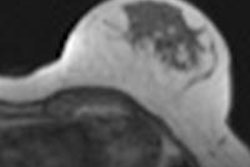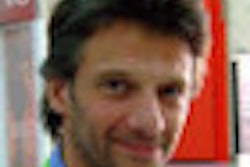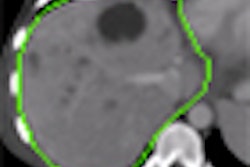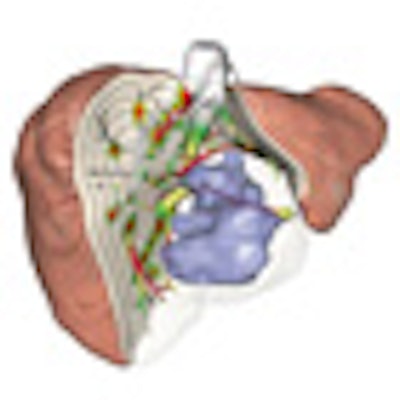
Fraunhofer MEVIS, Institute for Medical Image Computing, in Bremen, Germany, is a research and development center for computer assistance in image-based medicine. After almost 15 years of being an independent not-for-profit research center at the University of Bremen, it was transformed in 2009 into an institute of the Fraunhofer Society, the largest organization for applied research in Europe.
Directed by Prof. Heinz-Otto Peitgen, Fraunhofer MEVIS has strengthened its expertise in four particular fields of research: modeling and simulation, medical image acquisition, image registration, and computer-aided detection and diagnosis. Recent developments of Fraunhofer MEVIS will be presented at the Imagine Workshop presented by the European Institute for Biomedical Imaging Research (EIBIR).
The development of clinically useful image-based computer assistance for patient-specific diagnosis and therapy has been the focus of Fraunhofer MEVIS since its inception in 1995. Based on the software platform MeVisLab (www.mevislab.de), more than 70 interdisciplinary researchers are developing image-based software assistants for epidemiologically significant diseases such as oncological disorders; diseases of the brain, liver, and lung; as well as the cardiovascular system.
Fraunhofer MEVIS is connected with the University of Bremen and the Jacobs University Bremen through four professorships. In April 2010, the Fraunhofer MEVIS Project Group for Image Registration was founded at the University of Lübeck, Germany. The field of computer-aided detection and diagnosis (CAD) is developed through a partnership with the University of Nijmegen, the Netherlands.
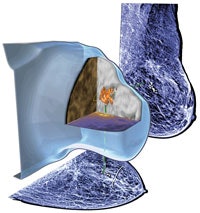 Combined aspects of multimodality breast imaging and diagnosis in HAMAM. Registered multimodal images (MRI, ultrasound, and PEM) of the segmented lesion representing different physical and biological properties. They are visualized together with a correlated view of the breast MRI volume and the mammographic projections.
Combined aspects of multimodality breast imaging and diagnosis in HAMAM. Registered multimodal images (MRI, ultrasound, and PEM) of the segmented lesion representing different physical and biological properties. They are visualized together with a correlated view of the breast MRI volume and the mammographic projections.
HAMAM
An example of the R&D activities of Fraunhofer MEVIS is the project HAMAM (Highly Accurate Breast Cancer Diagnosis through Integration of Biological Knowledge, Novel Imaging Modalities, and Modeling) funded by the European Commission within the Seventh Framework Programme. The aim of HAMAM is the seamless integration of patient information and multimodality image data in a clinical workstation for improved diagnosis of breast cancer via established (mammography, DCE-MRI) and newer (tomosynthesis, 3D ultrasound, positron emission mammography [PEM]) breast imaging modalities. Eight of the leading European research institutes and centers for breast cancer diagnosis cooperate in the HAMAM project. It is scientifically coordinated by Fraunhofer MEVIS and supported by an international clinical advisory board consisting of recognized experts from Europe and the U.S.
Recent developments
Medical images enable generalized models of biophysical and pathological processes, as well as diagnostic and therapeutic concepts, to be adapted and optimized to the specific needs of an individual patient. Recent developments at Fraunhofer MEVIS are targeting four promising fields of medical imaging and image computing:
Modeling and simulation (Prof. Tobias Preusser): Mathematical modeling and numerical simulation of biophysical and pathological processes are essential for a reliable patient-specific diagnosis and therapy. An example is the planning and risk assessment of radiofrequency ablations (RFA) of liver tumors. Based on the knowledge of the individual anatomy of a patient's liver, RFA-induced thermo lesions can be calculated and optimized in advance, taking into account the cooling effects of the blood flow.
Medical image acquisition (Prof. Matthias Guenther): Efficient medical image computing requires close interaction with the image acquisition. This is especially true for MRI with its huge variety of imaging protocols and sequences. The mutual optimization of MR image acquisition and computation for various clinical applications is therefore a second recently developed field of research at Fraunhofer MEVIS. Like the working group for modeling and simulation, the group for medical image acquisition is headed by a dedicated foundation professorship.
Image registration (Prof. Bernd Fischer): Accurate and efficient fusion of images from different modalities, time points, or patients is a ubiquitous task in medical image computing. It has a strong relevance to many clinical applications such as multimodality imaging, therapy planning, image guidance, and response monitoring. This field of strategic importance is developed in close cooperation with the newly established Fraunhofer MEVIS Project Group at the University of Lübeck.
Computer-aided detection and diagnosis: CAD applications for early detection of breast and lung cancer are developed in a partnership with Prof. Karssemeijer and Prof. van Ginneken at the University Medical Center in Nijmegen.
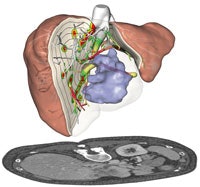 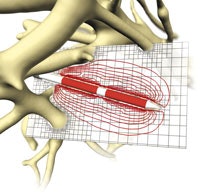 |
| Left: Risk analysis for surgical resection of a centrally located tumor. The individual liver anatomy was calculated based on preoperative CT images. The distance of the hepatic vessels to the tumor is indicated by a traffic light color scheme. The planned cutting planes preserve the entire left liver and part of the right liver, maximizing the volume of tumor-free remnant tissue. Risk structures, such as the surrounding of important vessels crossing the cutting planes, are color-coded according to their distance to the vessel. Right: Simulation-based calculation of heat distribution for an RFA applicator derived from patient-individual CT images. The temperature is calculated in the grid crossings. Areas of high temperature variation around the applicator (heat source) and the vessels (heat sink) are resolved by a finer grid. The red isolines represent locations of same temperature. The small distances of isolines close to the applicator indicate a large decrease in temperature. The cooling effect of vessels induces a deformation of isolines. |
Fraunhofer MEVIS maintains an international network of more than 150 clinical, scientific, and academic partners. In cooperation with the spin-off MeVis Medical Solutions AG and other industrial partners, Fraunhofer MEVIS has established a quality-assured innovation chain from basic research, to clinical prototypes, to certified medical products.
For more information, visit www.mevis.fraunhofer.de
Originally published in ECR Today March 7, 2011.
Copyright © 2011 European Society of Radiology




